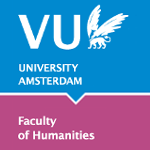
|
Digital Humanities Workbench |
Home page > Special topics > E-literature > Characteristics Characteristics of electronic literature
In many publications (see e.g. the publications mentioned in the introduction),
an attempt is made to distinguish genres in electronic literature, such as
hypertext literature, interactive literature, multimedia literature flash
poems and computer-generated
poetry. Because this distinction is not always unambiguous (hypertext
literature might also contain multimedia elements and multimedia literature can
also be interactive) this workbench contains a description of some possible
characteristics of electronic literature. Many forms have more than one of these
characteristics.
Non-linearityNon-linearity means that a work cannot or does not have to be read as continuous text, but can be read in various ways. This characteristic is closely linked with interactivity (see below), because the reader usually has to decide how he/she wants to continue reading the text at various points in the text. Hypertext is a closely related technique. Within electronic literature, hypertext literature (and in particular hypertext fiction) is often distinguished as a specific genre. Just like traditional printed literature, a lot of hypertext literature (especially novels) are commercial products. This is the case, for example, for the classic Afternoon, a story (Michael Joyce, 1987/1990), published by Eastgate. Other publications by this publisher of English-language hypertext fiction include Victory Garden (Stuart Moulthrop, 1995) and Patchwork Girl (Shelley Jackson, 1995).Here is an example of hypertext literature on the Internet: Hegirascope (Stuart Moulthrop, 1997/1998)[hypertext fiction] InteractivityInteractivity means that the reader largely determines how a text is read, which turn a story takes, when the next portion of a work is shown, or whether a particular picture is shown or sound is played, for example. Although this characteristic is oftenconnected to non-linearity (see above) and thus with hypertext fiction, this is definitely not always the case.Examples: The Jew's Daughter (Judd Morrissey) Blue Hyacinth (Jim Anderson) [interactivity, motion] and other Stir Fry Texts MultimedialityIf text is combined with images, sound, animations and/or video, we call this multimediality. This is an important feature of electronic literature.Examples: Slaaplied (Tonnus Oosterhof) [text and music]  Faith (Robert Kendall) [use of colours, animation, music, timing and motion,]
Mobility and variabilityCertain types of electronic literature are not static. For example, it is possible play with the place of letters and/or words in the text by making them move over the screen in order to support what is being told in some way. Portions of text can also be interchanged (whether or not after reader input), so that not only the form of a poem, for example, changes during reading, but its contents as well.Example: The Dreamlife of Letters (Brian Kim Stefans)
TransienceSome electronic literature isnotpermanent butephemeral and temporary, because it takes a different shape every time it is viewed and cannot be stored in a single, fixed form. This characteristic is related to mobility and variability, as mentioned above, but also has its own aspects. For example, it is an important feature of computer-generated poetry. In this genre (computer-generated poetry), a (sequence of) text is produced based on pre-programmed instructions and a certain basic vocabulary. This process, which does not lead to a fixed result, unfolds during the act of reading and can sometimes also be directed by reader instructions.Examples: Emotionally configurable poem generator (Peter Howard) [computer-generated poetry] Regime Change (Noah Wardrip-Fruin e.a.) [computer-generated poetry]
Three-dimensionalitySome works use (the illusion of) a third dimension to present and manipulate text.Examples: Five by Five (Dan Weber) [3d; motion] Heart Pole (David Knoebel) [3d; motion] Of course, computer displays are limited when it comes to 3D-presentation, but a major development in this field is CAVE, a space equipped with screens on which computer-generated images are projected. Together with the special glasses that CAVE users have to wear, this creates the impression that the images emanate from the walls in 3D. An example of a literary application of CAVE is Screen, by Noah Wardrip-Fruin et al.
Fusion with other art formsWhereas in electronic literature the literary aspect is central and other media are used to support and enhance it, there are other art forms that are more of a fusion of electronic literature with other (digital) art forms, such as the visual arts, film, music and computer games, in such a way that the dividing line between the one art form and the other one blurs. Interactive fiction, a term used for storytelling text games, is a good example of thist type of fusion, although it can also be seen as a genre of its own.Examples: The Child (Alex Gopher en Antoine Bardou-Jacquet) [video; narrative calligram] Fašade: a one-act interactive drama
CollaborationAlthough literature spread through new communication media such as Email, SMS, wikis, rss-feeds and blogs is not covered by the definition of electronic literature used in this Workbench (see the introduction), these forms are, in fact, the product of a new way of creating literature that is well worth mentioning. This involves works of literature that are created in the context of a literary community that can influence how the text is produced. These works 'grow', as it were, as readers make their own contributions to them, which can come in all shapes and sizes. Kate Pullinger and Chris Joseph, for example, are currently working on Flight Paths, using the CommentPress system. They call this a 'networked novel', where reader input can influence the development of the work. |
Other topics in this section: Introduction Techniques Links |
